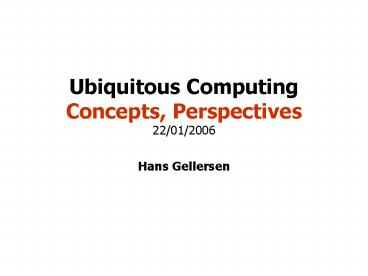Ubiquitous Computing Concepts, Perspectives 22012006 PowerPoint PPT Presentation
1 / 18
Title: Ubiquitous Computing Concepts, Perspectives 22012006
1
Ubiquitous ComputingConcepts, Perspectives
22/01/2006
- Hans Gellersen
2
Computers and Users
Source Tom Rodden
3
A Changing World
- The world is changing rapidly
- The familiar arrangement of computer and user
does not hold anymore - Moores Law has led to
- computer size too small to see
- computer cost so little as to be free
- computer speed too fast to imagine
- computer networks larger than can be considered
- gt Many more computers than people
4
Where are the Computers ?
- Something like 98 of the worlds microprocessors
arent in what we would identify as computers - White goods washing machines, dish washers, ...
- Brown goods TVs, DVD players, CD players, ...
- Cars engine management, security, ...
- Sales radio tags
- These are Invisible Computers
- no direct user interface
- no explicitly user-visible function
5
More than we possibly imagined
- In the mid-80s I attended a conference on
microprocessor design. One of the speakers stood
up and predicted that the world demand for
microprocessors could exceed several million
units a year by 2000. He was immediately attacked
from the floor one person shouted Millions?!
what are we going to have , a computer in every
doorknob? - Ten years later I went back to the same hotel
Id stayed in for that conference. Instead of a
key, they gave me a plastic card. I swiped the
card in the lock to get into the room. - There was a computer in every doorknob.
- Danny Hillis
Source S. Dobson
6
Computers Size Number
size
number
One Computer for many people
Le Grand Napoleon
One Computer for everyone
Many Computers for everyone
7
Theories of Ubiquitous Computing
- Weisers vision of Ubiquitous Computing
- Seminal article The Computer for the 21st
Century, Sci.Amer., Sept 1991 - A societal vision, not just a computer vision
- Related Technology Perspectives
- Developed around particular technological
developments or ideas - Mobile, Wireless, Wearable etc
- Conceptual Perspectives
- Concepts and paradigms relating to ubiquitous
computing - Context-awareness, Invisibility, etc
8
Weisers Vision
- Mass-deployment of computing in everyday life
- ...the next generation computing environment
in which each person is continually interacting
with hundreds of nearby wirelessly connected
computers. The point is to achieve the most
effective kind of technology, that which is
essentially invisible to the user I call this
future world Ubiquitous Computing.
9
Weisers Vision
- Not just more more computers networking
- Main concern to overcome the disconnection of
computers from the real world situations in which
they are used - The idea for UC first arose from contemplating
the place of todays computer in actual
activities of everyday life. studies of work
life teach us that people primarily work in a
world of shared situations However the
computer today is isolated and isolating from the
overall situation, and fails to get out of the
way of the work.
10
AmI - Ambient Intelligence
- IT Vision promoted in Europe
- Developed by the ISTAG Advisory Group for the
European Commission - like Ubicomp a societal vision, concerned with
fundamental change in perspective on IT - The environment is the interface to an
otherwise invisible computing infrastructure - stronger emphasis on intelligent action on behalf
of the userpeople living easily in digital
environments in which the electronics are
sensitive to people's needs
11
Pervasive Computing
- Originally promoted by IBM
- In the academic world usually treated as
synonymous to ubiquitous computing - Some view Pervasive as more technology-driven,
and Ubicomp as more user- and application driven
12
Related Technology Perspectives
- Embedded Computing
- An embedded system is a special-purpose computer
system, which is completely encapsulated by the
device it controls. - An embedded system has specific requirements and
performs pre-defined tasks, unlike a
general-purpose personal computer
13
Related Technology Perspectives
- Wireless computing
- freedom of movement
- Ad hoc Networking
- Use of services without need for a priori
knowledge, or pre- configuration - Mobile computing
- powerful computing in a carry-able form
- Wearable computing
- operational while on the move
- body-oriented technologies, intimate, perceived
as part of self, e.g. intelligent clothing(in
contrast to environment-oriented technologies)
14
Related Technology Perspectives
- Tangible User Interfaces
- Physical manipulation of digital information
- Augmented Reality, Mixed Reality
- Overlaying information in the physical world
- Combining/blending physical and digital
interaction - Sentient Computing
- Use of sensors to understand the environment
- Smart devices, smart homes etc
15
Conceptual Perspectives
- Context-aware Computing
- Shared context between computer and user, in
particular in relation to situation in the world - Location, activity, social context etc
- Context as a resource for computers to adapt
their behaviour to the users situation
16
Conceptual Perspectives
- Ambient Computing
- Technology in the background of attention
- Available and ready-to-hand to be brought to the
foreground - Example LiveWire visualising network traffic (N.
Jeremijenko)
17
Conceptual Perspectives
- Invisible Computing
- What does invisible in use really mean?
- How aware of computing should people really be?
- Physical invisibility (completely embedded)
- Perceptual invisibility (ambient, at the
periphery) - Routine invisibility (unremarkable, mundane)
18
Conclusion
- Characteristics of Ubicomp Systems
- not defined by any particular set of technologies
- nor by any specific set of behaviours
- but we can list some characteristics that seem
important - Context-Awareness use of sensors to model a
situation - Physical Integration some form of integration
between computing system and physical environment - Spontaneous Interaction usable on an ad hoc
basis, for unplanned tasks, without
pre-configuration - Invisibility functioning on the periphery of
human awareness, available but not
attention-demanding

